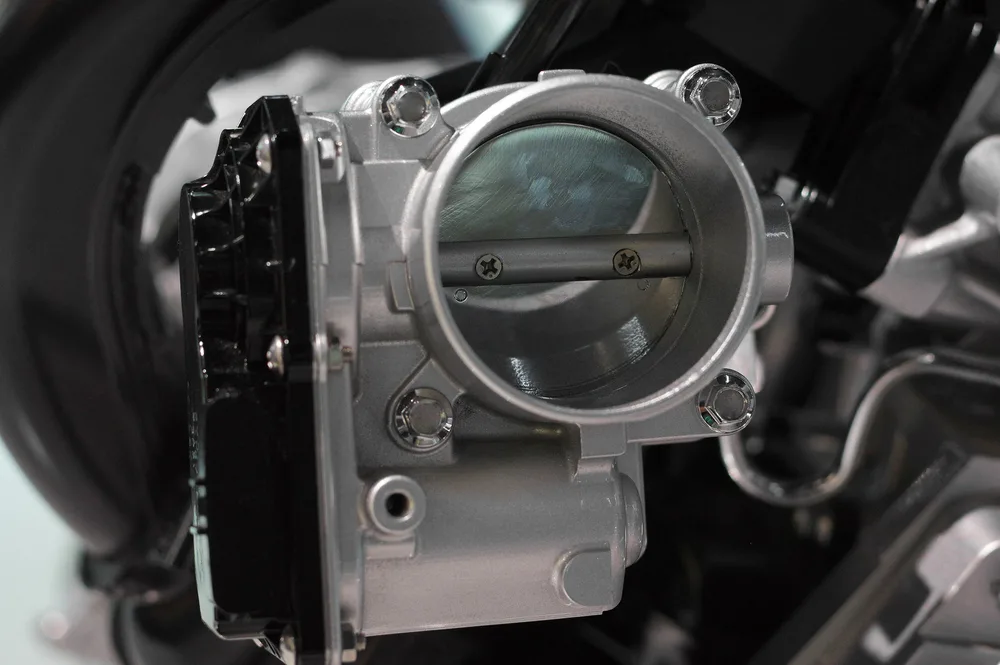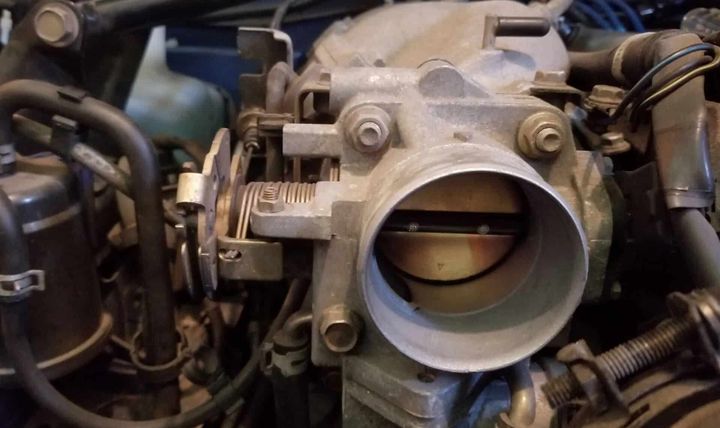


The throttle body is a crucial component of a vehicle's engine that regulates the amount of air flowing into the combustion chambers. It plays a vital role in controlling the engine's power output, fuel efficiency, and overall performance. Over time, the throttle body can become clogged with carbon deposits, dirt, and debris, leading to various issues that may necessitate its replacement.

Before we dive into the nitty-gritty details, let's start with a quick refresher on what a throttle body is and its role in your vehicle's engine.
| Component | Function |
|---|---|
| Throttle Body | Regulates the amount of air flowing into the engine |
| Throttle Position Sensor (TPS) | Ensures the engine receives the right air-fuel mixture for optimal performance and fuel efficiency |
The throttle body is essentially the gatekeeper that works in tandem with the TPS to control the engine's air intake.
Over time, various factors can contribute to the deterioration of your throttle body, leading to the need for replacement. Here are the most common culprits I've encountered in my years of experience:
Carbon Buildup
Electrical Issues
Physical Damage
One of the primary reasons for throttle body failure is carbon buildup. This occurs when crankcase gases containing oil vapors and exhaust gases enter the intake system through the Positive Crankcase Ventilation (PCV) valve. These contaminants can accumulate on the throttle body, restricting airflow and affecting the movement of the throttle plate. As the buildup worsens, it can disrupt the air-fuel mixture, leading to a host of performance issues.
In modern vehicles with electronic throttle bodies, electrical issues can also cause problems.
| Electrical Issue | Potential Consequence |
|---|---|
| Corrosion in the electrical connector | Inaccurate readings |
| Malfunctions in the throttle valve actuator | Improper throttle body operation |
| Throttle position sensor issues | Inaccurate readings |
Let's not forget about good old-fashioned physical damage. If any of the following components sustain damage, it can compromise the entire system, necessitating a replacement:

Throttle flap
Throttle shaft
Mechanical linkages to the throttle cable
Throttle body/TP sensor electrical connectors
Now that you know the potential culprits, how can you tell if your throttle body is the root cause of your engine woes? Here are some telltale signs to watch out for:
Rough idling
Engine stalling
Check Engine Light or other warning lights
Acceleration issues
Poor fuel economy
Engine running rough
Limp mode
One of the first indicators of a faulty throttle body is rough and uneven engine idling. This issue may initially only occur when the engine is cold, but as the problem progresses, it can become more persistent.
A dirty or malfunctioning throttle body can disrupt the air-fuel mixture, causing the engine to stall, especially during idling or while driving.
If the throttle position sensor is malfunctioning, it can trigger the dreaded Check Engine Light or other warning lights like the EPC light on some vehicles.
Are you experiencing any of the following?
Sluggish acceleration
Delays in response when pressing the gas pedal
Jerking/shaking during acceleration
These could be signs of a throttle body issue.
A faulty throttle body can significantly increase fuel consumption by 30% or more, so if you've noticed a sudden drop in fuel efficiency, it's worth investigating.
As the problem progresses, you may notice that your engine is running rough, resembling an engine misfire.
In severe cases, your vehicle may go into limp mode, which limits acceleration to prevent further damage to the engine.
If you've identified that your throttle body is the culprit, there are two main repair options:
| Repair Option | Description |
|---|---|
| Cleaning the Throttle Body | Involves removing the throttle body, spraying a throttle body cleaner, scrubbing with a brush, and reinstalling it. Recalibrating the throttle position may also be required after cleaning. |
| Replacing the Throttle Body | If cleaning is ineffective or there is physical damage, the throttle body needs to be replaced. This is a more involved process and can typically cost between $500 and $1000, including parts and labor. |
When replacing the throttle body, it's crucial to ensure that the new component is compatible with your vehicle's make, model, and year. Follow the manufacturer's instructions for proper installation and calibration procedures, and use high-quality throttle body cleaners and lubricants during the replacement process.
As with most automotive components, prevention is key when it comes to throttle body longevity. Here are some tips to help you avoid premature failure:
Follow the manufacturer's recommended maintenance schedule for throttle body cleaning and inspection
Use high-quality fuel and air filters
Avoid excessive idling or frequent short-trip driving
Promptly address any engine oil leaks or issues with the Positive Crankcase Ventilation (PCV) system
Adhering to the recommended maintenance schedule for throttle body cleaning and inspection can go a long way in preventing issues. Regular cleaning can remove any buildup before it becomes a significant problem.
Using high-quality fuel and air filters can help reduce the amount of contaminants entering the intake system, minimizing the risk of carbon buildup on the throttle body.
Excessive idling
Frequent short-trip driving
Both of these habits can increase the likelihood of carbon buildup, as the engine doesn't have a chance to reach optimal operating temperatures.
Promptly addressing any engine oil leaks or issues with the Positive Crankcase Ventilation (PCV) system can prevent contamination from entering the intake system and causing throttle body problems.
Maintaining a healthy throttle body is crucial for ensuring your vehicle's optimal performance, fuel efficiency, and longevity. By being aware of the symptoms, understanding the causes, and following proper maintenance practices, you can minimize the need for costly throttle body replacements and keep your ride running smoothly.
Remember, prevention is key, but if you do encounter throttle body issues, don't hesitate to seek professional assistance. A skilled mechanic can diagnose the problem accurately and recommend the best course of action, whether it's a thorough cleaning or a complete replacement.
Happy motoring, and may your throttle body remain clean and functional for many miles to come!
The throttle body regulates the amount of air flowing into the engine's combustion chambers. It works with the throttle position sensor to maintain the proper air-fuel mixture.
Carbon buildup occurs when crankcase gases containing oil vapors and exhaust gases enter the intake system through the PCV valve and accumulate on the throttle body over time.
Common signs of a bad throttle position sensor include rough idling, stalling, check engine light, acceleration issues, and poor fuel economy.
A dirty throttle body can sometimes be cleaned using a throttle body cleaner and a brush, but if cleaning is ineffective or there is physical damage, replacement is necessary.
Replacing a throttle body typically costs between $500 and $1000, including parts and labor.
Following the manufacturer's recommended maintenance schedule, using high-quality filters, avoiding excessive idling and short trips, and addressing oil leaks/PCV issues can help prevent throttle body problems.
Yes, if the throttle position sensor is malfunctioning, it can trigger the check engine light or other warning lights.
Limp mode limits acceleration to prevent further engine damage. A severely faulty throttle body can cause the vehicle to go into limp mode.
Yes, after cleaning the throttle body, it may be necessary to recalibrate the throttle position sensor to ensure accurate readings.
Yes, a faulty throttle body can cause jerking or shaking during acceleration due to disruptions in the air-fuel mixture.

Sarah isn't your average gearhead. With a double major in Mechanical Engineering and Automotive Technology, she dived straight into the world of car repair. After 15 years of turning wrenches at dealerships and independent shops, Sarah joined MICDOT to share her expertise and passion for making cars run like new. Her in-depth knowledge and knack for explaining complex issues in simple terms make her a valuable asset to our team.













